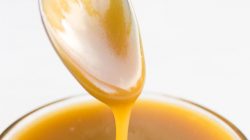The Different Flavors and Applications of Soy Sauce
Soy Sauce is so much more than just a condiment for your Asian food.
While this fermented soybean concoction is typically paired with Chinese and Japanese cuisine, this umami flavor enhancement has a nuanced history that dates back 2,000+ years and continues to produce a variety of flavors that can be used across a myriad of food applications.
Let’s review just how complex and savory soy sauce can be.
How Soy Sauce is Traditionally Made
Traditional soy sauces take months to create through a process of soaking and boiling soybeans, roasting and crushing wheat and mixing the ingredients together to form a grain mixture that generally has the fungi genus Aspergillus added to it along with yeast. After going through the brewing, pressing and pasteurization process, the resulting soy sauce is stored to be aged and eventually placed on shelves.
On the other hand, the natural brewing process can be bypassed to create a chemically-produced soy sauce that can ready within days and placed on the store shelves to be sold directly. Overall, naturally-brewed has a deep aroma and complex flavor while chemically-produced soy sauce is simply, super salty.
What you may not know, though, is that soy sauce is closer to wine than you think. The more it’s aged, the better the mouthfeel.
Popular Soy Sauce Flavors
As expected, the longer you age soy sauce, the more complex and nuanced the flavor becomes. In the same way, ingredient variants cause significant shifts in flavor. For that reason, many different varieties have been created, including light and dark versions.
You’re familiar with traditional soy sauce – a dark, salty sauce that may have a different balance of water, salt and fermented soy depending on where you go, but is typically universal in flavor, taste and aroma.
But did you know there are light soy sauces that are used for seasoning light dishes or dips? In fact, depending on the blend, aging or fermentation process, you can uncover intense flavors and create thick sauces, dark sauces and even sweet sauces.
Popular Soy Sauce Applications
Generously applying across your Chinese stir-fry or mixed alongside wasabi in your Japanese sushi are maybe the two most common soy sauce applications, but there are other dishes just begging for that magic umami flavor.
Many Asian applications of soy sauce can be found online for delectable dishes like beef noodle soup, kung pao beef, stir-fried chicken with cashews and, our favorite, slow-cooked Asian BBQ Ribs.
Our Favorite Non-Asian Soy Sauce Applications
Next time you’re getting inventive with your flavor enhancement, we have a few non-Asian soy sauce applications to consider.
Add soy sauce to dishes that use a sweet BBQ sauce or traditional casseroles that need a savory boost. Crunchy, breaded options like coconut shrimp or fried chicken perfectly compliment this salt replacement with super juicy meat. Soy sauce even spreads wonderfully across your bacon, egg and meat breakfast – we prefer shrimp!
So, what variety of soy sauce ingredients work best?
Introducing Nikken Foods’ Top Soy Sauce Powders:
Nikken Foods has the perfect soy sauce companion for all your soups, sauces/marinades, salad dressings, gravies, dips, seasonings, snacks, appetizers, entrees, breads/crackers and dressings/stuffings.
Check out 5 soy sauce products that offer sodium reduction and flavor enhancement:
Like most traditional powders, this beany, umami sauce is a naturally-fermented soy sauce spray-dried on a maltodextrin carrier. It provides a light tan, free-flowing powder that is completely soluble in water and contains soybeans and wheat.
This brownish-red fine powder is a naturally-fermented soy sauce, spray-dried on a maltodextrin carrier and contains traditional ingredients of fermented soybeans, wheat and salt to create a classic umami mouthfeel. The roasted notes bring a complexity and additional savory layer to any application/
This allergen/gluten-free option is a fermented rice extract spray-dried on a native corn starch carrier. It provides a new umami taste in a wide array of products, including both vegan and meat-based products.
Another naturally-fermented soy sauce spray-dried on a maltodextrin carrier, this Soy Sauce Powder contains only soybeans and salt – no wheat. It provides a light tan, free-flowing powder that is completely soluble in water and features a mild authentic flavor and aroma of soy sauce. This powder plays a leading role with sodium reduction and flavor enhancement applications.
Tamari style is also a naturally-fermented Soy Sauce that is spray-dried on a maltodextrin carrier. Similarl to the wheat-free product, this variation is a light tan, free-flowing powder that is completely soluble in water, yet provides a smoother flavor than regular soy sauce that can be added for any flavor enhancement applications.
Shop the Nikken Foods Pantry
Nikken Foods has a variety of soy sauces to meet every need. Be sure to keep an eye out for more exciting (and very tasty) USDA organic certified soy sauces that are currently in production with Nikken Foods and will be available soon!
To learn more about all-natural, flavor enhancement ingredients, please visit www.nikkenfoods.com.

